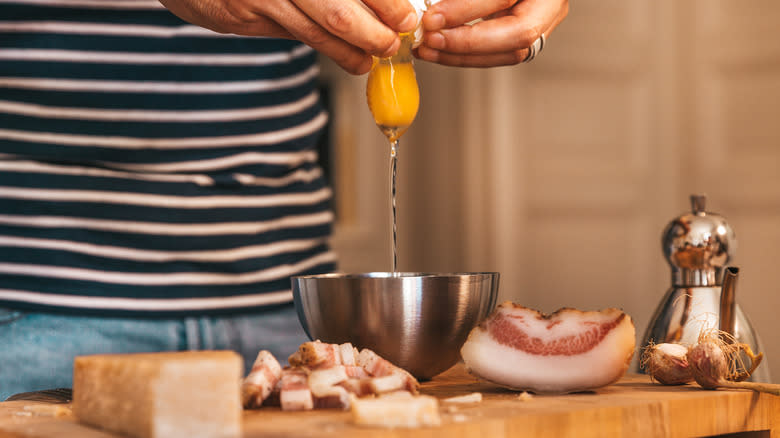Seriously, Use Beans Instead Of Pasta In Your Next Carbonara

When it comes to versatile, affordable, and tasty meals, pasta is a dish that's at the top of the list. You can turn it into meals like spaghetti and meatballs, or go for something creamy like chicken alfredo. Speaking of creamy pasta dishes, one tasty option is to make a carbonara. Pasta carbonara calls for just a few ingredients — pasta, cheese, pork, and egg — and results in a dish packed with salty flavor and a velvety texture.
If you love pasta carbonara, there's a slight twist on this recipe that you should try: bean carbonara. The beans give a new, softer texture to the dish while retaining all of the rich, buttery flavor of the pasta sauce. Plus, the bean swap piles on the protein in this meal. Best of all, it's an easy swap to make and may even save you time since you don't have to cook your pasta.
Read more: 7 Bacon Brands You Should Buy And 7 You Might Want To Skip
Selecting Your Ingredients And Putting Them All Together

To start, you'll need to choose what beans to use. Most people opt for light beans, such as butter beans, white beans, or cannellini beans, as these tend to pair better with the sauce and give a flavor profile closer to that of the pasta. However, you could also experiment with other types, such as pinto, red, or kidney beans. Just note that these varieties may lead to a meatier taste and clash with the butteriness of the sauce.
Once you've chosen your beans, you'll need to start by chopping the meat into small pieces, whether that's pancetta, bacon, or guanciale. Whichever you select, you want to make sure it's a fatty pork so that it adds flavor to the sauce. Then, cook it in a frying pan before tossing in your beans. When you add your beans, the key is to throw in the liquid they were preserved or cooked in. Just like you'd add pasta water to traditional carbonara, you'll need the bean water to make the sauce.
The final step is to beat an egg with about 1 ounce of parmesan cheese. Make sure you're using the fresh variety, as it will melt more easily and is also much more flavorful, enhancing your dish. Then, stir the mixture into your beans and get ready to serve your dish!
How To Serve You Bean Carbonara

Once your dish is cooked and ready to go, you're welcome to eat it as is. However, you can also finish it off with a couple of sides or toppings. If it's toppings you're going for, you could lay a few spears of cooked asparagus atop the plate, adding a pop of color and a refreshing flavor to balance out the richness of the sauce. Similarly, you could pair the dish with a few florets of cooked broccoli. For those who are missing the carbs of the pasta, another choice could be to serve your meal with some garlic bread.
As for toppings, there are plenty of options to try there, too. A shaving of parmesan cheese can bring out the creamy, salty flavors of your pasta. Or, add some herbal notes with a sprinkling of freshly chopped parsley. You could also keep things simple and grind some black pepper over the top of the dish. Whichever way you go, you'll wind up with a dish that's packed with flavor and has a unique and distinct texture from your standard pasta carbonara.
Read the original article on Daily Meal.


